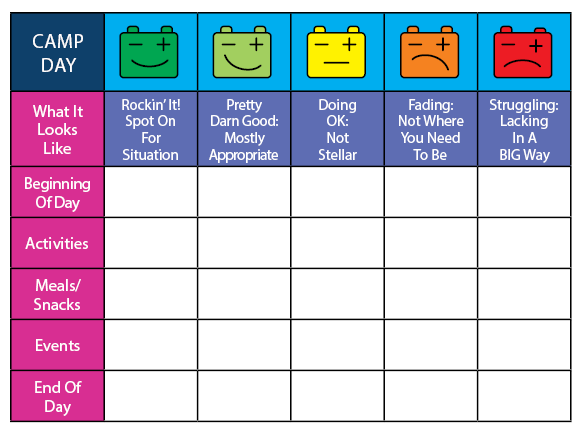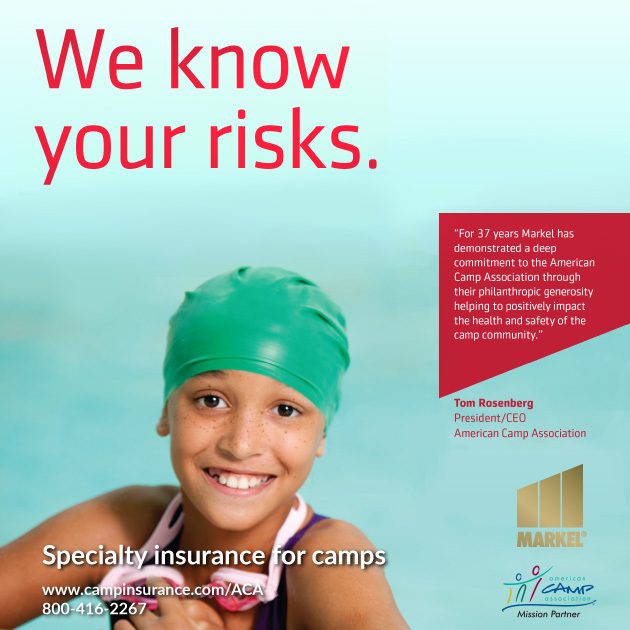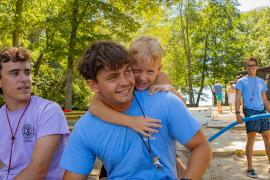As you can probably imagine and were most likely told in your interview, working at camp requires a lot of energy and enthusiasm. This is 110 percent true. Camp is, without a doubt, a place where these two attributes can be found at very high levels. You may be wondering just how much of them are needed on an individual or daily basis. Chances are, you will hear on multiple occasions throughout the summer from camp leadership that staff are lacking energy and enthusiasm. But high levels of both are neither realistic nor sustainable (or desirable) all the time.
Beginnings and endings of the camp day, activities, mealtimes, and special events each call for varying levels of these vital commodities. What camp directors really want you to have is an appropriate level of energy and enthusiasm, depending on what the situation calls for. Stick around for some guidance on how to find your "sweet spot" of each, as well as an effective system to gauge and monitor your own energy and enthusiasm for different situations in the camp schedule — to maintain a manageable pace all summer long.
It wasn’t until last summer that I really put some brainpower into thinking about the relationship between energy and enthusiasm. Wondering, "How are the two related? Does high energy always mean high enthusiasm? Is low energy usually accompanied by low enthusiasm? Is it possible to have high energy but low enthusiasm or vice versa?" I imagined various situations at camp, and I came to the conclusion that equal levels of energy and enthusiasm do not always go hand in hand. Let me explain.
According to the Oxford Online Dictionary (2020), energy is "the strength and vitality required for sustained physical or mental activity." When I think of having energy at camp, I envision someone who has get-up-and-go, is full of pep, and exudes spirit. Enthusiasm is defined as "intense and eager enjoyment, interest, or approval (Oxford Online Dictionary, 2020). Someone who depicts eagerness, passion, and zest paints a clear picture of having enthusiasm at camp. Energy and enthusiasm together can be a dynamic duo.
Opening day of each camp session is universally a time when staff are expected to exhibit a high degree of both energy and enthusiasm. Actively meeting and greeting campers and/or parents by giving a big smile, making eye contact, offering a friendly handshake, and taking the initiative to help unload the car or assist with a backpack signifies high energy.
You can express a high level of enthusiasm on the first day of camp by:
- Knowing something about each of your campers before they arrive to make them feel welcome
- Helping campers make connections with each other
- Anticipating questions by letting campers know what is happening next
- Setting expectations with the group so they begin to feel a sense of being comfortable and safe
High energy and enthusiasm will put kids and their parents at ease as campers embark on their summer adventure.
You can probably think of situations when high energy is not always accompanied by high enthusiasm. In the camp context, you may discover folks who bring a lot of energy or momentum to an activity or task, such as cabin cleanup or putting things away at the end of a class, but it is not channeled in a way that rallies the troops to take action in a positive direction.
In those cases, while there is a certain boisterousness to the mood or even a lot of laughter and humor, there is also a message being sent to campers that says, "I really don’t want to do this, and I may not really care about the impact this will have on the greater camp community." I see it as a disconnect; the energy is there, but the enthusiasm is clearly missing the mark.
On the other hand, low energy does not necessarily indicate someone is lacking in enthusiasm. At mealtimes, for example, it is usually not desirable for campers to be bouncing off the walls while eating. Having a calm demeanor, which may seem like low energy to an outsider looking in, may be just what is needed. Being engaged with the campers during meals, taking care to ask about their day, making sure each person gets a chance to take part in the conversation, and following up with thoughtful observations or additional questions is precisely what makes for a peaceful setting during meals. High energy (even pounding on the tables) may be invited back to the scene when everyone has finished eating and is ready to sing favorite camp songs.
Sitting off to the side and disengaging altogether is a prime example of low energy and low enthusiasm. Directing campers to clean up the cabin while sitting on your own bed is a sure way to send a message of "Do as I say, not as I do." Teaching basketball or other activity from a seated position and letting campers just play without any instruction or demonstration robs them of opportunities to gain or improve their skills. Hanging out with counselor friends instead of your camper group takes the focus away from your number-one priority, compromises supervision protocols, and falls into the category of low energy/low enthusiasm.
Fundamentally, there is no scenario at camp where low energy and low enthusiasm are on the menu. If you find yourself struggling to muster both on a regular basis, either a break (time off) is in order (with permission), or a trip to the health center may be a good idea to see if these symptoms are related to your overall well-being. Also, think about how your lack of energy and enthusiasm affects other staff. Are your coworkers having to pick up your slack and carry the weight because you don’t or can’t? Everyone has a bad day now and then (even at camp); however, if off days are the norm for you, the greater camp community will undoubtedly be affected.
So, how do you manage the levels of energy and enthusiasm appropriate for different situations within the typical camp day? How do you find your sweet spot so you can last for the marathon of camp and not the sprint? You can probably relate to the charging battery icon on our devices that we rely on to signify how much "juice" is left (or used) as a guide for monitoring your own energy and enthusiasm reserves.
- Being fully charged (100 percent) means you are "rockin’ it" and are spot on with energy and enthusiasm as called for by the situation.
- Seventy-five percent indicates appropriate levels of energy and enthusiasm and that you are "pretty darn good" for the given circumstances.
- Fifty percent says you are "OK, but not stellar."
- At 25 percent, your fading energy and enthusiasm are not where they need to be for the conditions.
- At 0 percent, you are really struggling; your energy and enthusiasm are nowhere close to what they need to be for what the situation requires.
Using this battery-charging analogy, it becomes easy to recognize what the various levels look like so that you can adjust accordingly and find your sweet spot for each camp activity. Starting with the beginning of the day, energy and enthusiasm should be high. What does "rockin’ it" look like? You arrive early to day camp so you are set to greet campers as they are dropped off. Give each camper a warm welcome and share exciting things about the day ahead. At sleepaway camp, rise before your campers and be ready to help them start their days (getting out of bed and dressed, making their beds, packing for the morning’s activities, engaging in cleanup, heading to breakfast, etc.).
Starting the day at "OK, but not stellar" looks like getting to day camp with little time to spare and taking campers to their first stop for the morning with minimal interaction. At overnight camp, you get up with your campers and half-heartedly help them get prepared for the day ahead. If you are really struggling in the morning, you most likely arrive late to camp or are up after your campers and rely on them to take care of themselves and prepare for the upcoming day.
"Rockin’ it" with energy and enthusiasm in activities means you arrive ahead of your campers (if possible), structure a well-planned lesson, prepare supplies and equipment so they are out and ready to be used, and engage with campers throughout the activity period. (As examples, think in the water during swim instruction, standing up and demonstrating proper shooting stance at archery, sitting at the table and engaging with campers for arts & crafts, etc.) "OK, but not stellar" resembles getting to the activity around the same time as campers, having a loose idea or plan for the lesson, and exhibiting average engagement with the campers. Arriving late to activity periods, winging the lesson without any preplanning or thought, and having minimal to no engagement with the campers is a sure sign that you are "struggling" with energy and enthusiasm.
Meals, as previously mentioned, are typically times for a sweet spot of low energy and high enthusiasm. In addition to connecting with campers while enjoying a meal, "rockin’ it" also shows that you are modeling and enforcing a civilized eating experience with basic manners (saying "please" and "thank you," waiting until everyone is served before starting, staying seated unless excused, etc.) and engaging in conversations with campers and relating to their interests (instead of conversing with staff on adult topics).
"OK" in terms of enthusiasm during mealtime may reflect partial engagement with campers with little follow-up beyond surface-level interactions and paying average attention to camper manners and noise level. If your battery is lacking in this area, campers will converse with each other and throw table manners and volume control out the window while your attention is elsewhere.
Special events generally call for both high energy and high enthusiasm when calibrating your sweet spot. Color War, Capture the Flag, and other popular large-group or all-camp activities usually fit into this category. You need to rock this — motivate your group, cheer for and encourage team members, and keep the peace. Functioning at this level makes the activity more fun for the campers and for you. If you are mostly engaged, but your body language says you would rather be someplace else, campers will pick up on this vibe. If your battery is dead for these events, the campers will certainly take charge (for good or bad) and will often struggle themselves to make it through without conflict. Your team’s dysfunction will make it clear that you have checked out.
The end-of-the-camp-day sweet spot is another time for low energy and high enthusiasm. Parents will greatly appreciate it if campers are sent home, either on the bus or with a family member, having had a great day at camp and eager to come back tomorrow. Consider giving campers talking points for when they share about their day or questions for parents that will engage campers beyond yes or no responses.
At sleepaway camp, make sure campers wind down before bed; a good night’s sleep is important for them and for you. Counselors who rock it at bedtime actively facilitate getting ready for lights out by having a system in place for campers to get cleaned up, change into pajamas, and brush their teeth. Check in with campers as a group or individually to find out highlights and growth opportunities from each exciting day.
If you are not totally on top of the bedtime routine, or if you’re operating at close to 0 percent, campers may be left to their own devices while getting ready for bed. That means you are not being vigilant to camper actions and interactions.
As depicted here, different situations in a typical camp day call for varying levels of energy and enthusiasm. Your energy level will vary throughout the day, but your enthusiasm should remain high to provide campers with the most engagement and the best possible experience. Ralph Waldo Emerson said, "Nothing was ever achieved without enthusiasm." He was right! Monitoring your levels of energy and enthusiasm (see chart) will help you discover your sweet spot for each time period as you move through the days and weeks ahead and adjust accordingly. Doing so will also make it easier to find and maintain a realistic pace all summer long!

Discussion Questions
- How are energy and enthusiasm related? Give examples of both high and low energy paired with high enthusiasm at camp.
- How can high energy and low enthusiasm be detrimental to the camp community?
- What should you do if you notice that you are consistently struggling to maintain appropriate levels of energy and enthusiasm?
References
- Oxford Online Dictionary. (2020). Energy. Retrieved from lexico.com/en/definition/energy
- Oxford Online Dictionary. (2020) Enthusiasm. Retrieved from lexico.com/en/definition/enthusiasm
Kim Aycock, MST, has 30+ years of experience developing young people with skills robots are unable to do. Blending the talents of a master teacher with the knowledge of a seasoned camp expert, Kim ignites the learning for varying levels of campers and staff worldwide. Kim speaks professionally at regional and national conferences, presents webinars, contributes regularly to Camping Magazine and ACA blogs, and serves as cochair of ACA’s Project Real Job Committee. More information can be found at: kimaycock.com. Kim may be contacted at [email protected].




